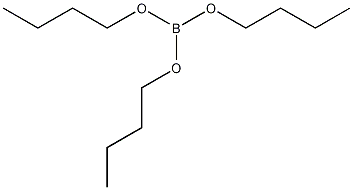Tri-n-butyl borate


Structural formula
| Business number | 079A |
|---|---|
| Molecular formula | C12H27BO3 |
| Molecular weight | 230.15 |
| label |
Tributyl borate, Butyl borate, Tri-n-butyl borate, Tributoxyborane, Boric acid tributylester, Tributoxyborane, [CH3(CH2)3O]3B, Semiconductor boron diffusion source, fire retardant, adhesive, Dehydration desiccant |
Numbering system
CAS number:688-74-4
MDL number:MFCD00009434
EINECS number:211-706-5
RTECS number:ED4900000
BRN number:1703865
PubChem number:24889407
Physical property data
1. Properties: Colorless liquid, easy to absorb moisture.
2. Density (g/mL, 20/4℃): 0.8583
3. Relative vapor density (g/mL, air=1): 7.9
4. Melting point (ºC): -70
5. Boiling point (ºC, normal pressure): 230-235
6. Boiling point (ºC, 5.2kPa): Undetermined
7. Refractive index (20ºC): 1.4096
8. Flash point (ºC): 93
9. Viscosity (mPa·s, 20ºC): 1.20
10. Autoignition point or ignition temperature (ºC): Not determined
11. Vapor pressure (kPa, 25ºC): Not determined
12. Vapor pressure (kPa, 103.8ºC): 10
13. Heat of evaporation (KJ/mol, 25ºC): 52.79
14. Heat of generation (KJ/mol): -1192.0
15. Heat of combustion (KJ/mol): 8060.4
16. Critical temperature (ºC): 470.0
17. Critical pressure (KPa): 19.9
18. Boiling point rising constant: 0.051
19. Solubility: soluble in water, soluble in benzene and dioxane.
Toxicological data
1. Acute toxicity: Mouse (oral) LD50: 2,150 mg/kg; Mouse (peritoneal) LDLo: 500mg/kg
Since the LD50 of table salt is 3,000 mg/kg, the acute toxicity of BPA is the same as that of table salt.
Ecological data
Do not allow undiluted or large quantities of products that are slightly hazardous to water to come into contact with groundwater, waterways or sewage systems. Do not discharge materials into the surrounding environment without government permission.
Molecular structure number�
1. Molar refractive index: 66.30
2. Molar volume (cm3/mol): 267.6
3. Isotonic specific volume (90.2K): 605.5
4. Surface tension (dyne/cm): 26.1
5. Dielectric constant:
6. Dipole moment (10-24 cm3):
7. Polarizability: 26.28
Compute chemical data
1. Reference value for hydrophobic parameter calculation (XlogP): None
2. Number of hydrogen bond donors: 0
3. Number of hydrogen bond acceptors: 3
4. Number of rotatable chemical bonds: 12
5. Number of tautomers: none
6. Topological molecule polar surface area 27.7
7. Number of heavy atoms: 16
8. Surface charge: 0
9. Complexity: 110
10. Number of isotope atoms: 0
11. Determine the number of atomic stereocenters: 0
12. Uncertain number of atomic stereocenters: 0
13. Determine the number of chemical bond stereocenters: 0
14. Number of uncertain chemical bond stereocenters: 0
15. Number of covalent bond units: 1
Properties and stability
Keep away from oxides and moisture. Easy to absorb moisture and decompose when exposed to water.
Storage method
Store in a container filled with dry inert gas and placed in a cool, dry place. The storage area must be locked and the keys must be given to the technical experts and their assistants. Avoid moisture and humidity. Keep away from oxidizing agents.
Synthesis method
1. Obtained from the reaction of n-butanol and boric acid.
Refining method: It mainly contains impurities such as boric acid and alcohol produced by hydrolysis. Refined by vacuum distillation.
2. Preparation method:
In a reaction bottle equipped with a dropping funnel and a fractionation device (30cm fractionation column), add 62g of analytically pure boric acid (1.0mol), n-butyl Alcohol (2) 333g (4.5mol), a few grains of zeolite. Heat with electric heating mantle until boiling. Control the distillation rate to about 40Ml/30min, the temperature at the top of the fractionating column to be 91°C, and the distillation is completed in about 2 hours. The distillate is an azeotrope of butanol and water. Place the azeotrope in a separatory funnel, separate the aqueous layer, dry the upper layer with anhydrous magnesium sulfate, then add it back to the reaction flask, and carry out fractionation as before. The temperature at the top of the fractionation column gradually rises to 110~112℃. Then perform fractional distillation under reduced pressure. First, unreacted butanol is evaporated, and then the fraction at 114-115°C/2.0kPa is collected to obtain 200g of tributyl borate (1) with a yield of 90%. [1]
Purpose
This product is an intermediate for preparing boron hydride compounds, a semiconductor boron diffusion source, a fire retardant, an adhesive, and a dehydration desiccant for anhydrous systems. Used as a solvent for resins, plasticizers, surfactants, bactericides, etc. It is also used to prepare semiconductor components, organic boron compounds and high-purity boron.
